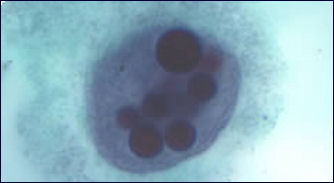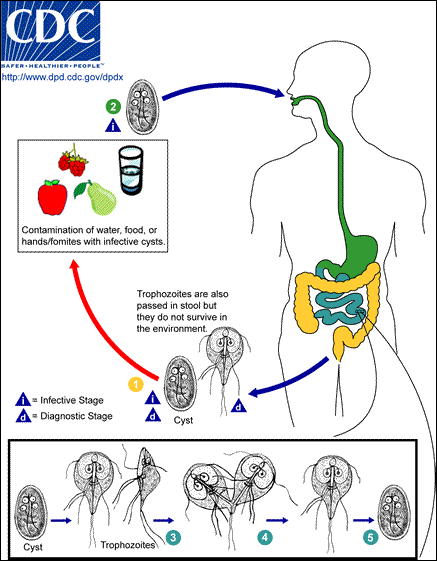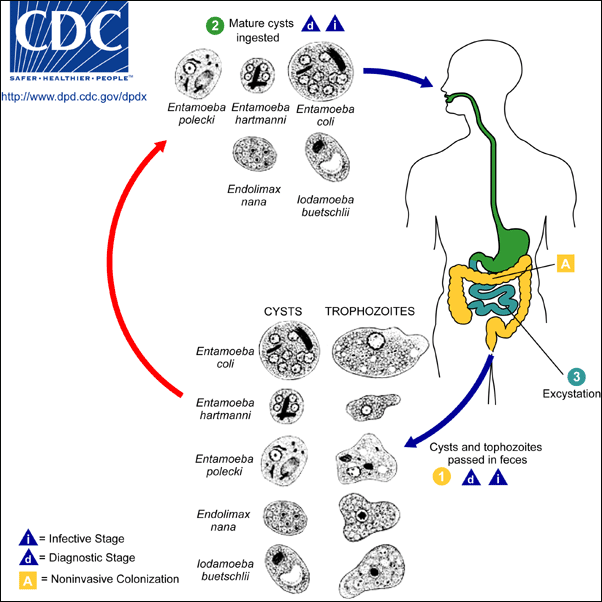WATER-BOURNE DISEASES

amebiasis About 6,000 people die each day of water-borne diseases such a typhoid, diarrhea, hepatitis cholera and dysentery. Dirty water kills more kids than AIDS, malaria , war and accidents put together.
More than 100 pathogens can cause illness if you drink or swim in water contaminated by sewage. They include viruses such hepatitis A, and norovirus Norwalk, and bacteria such as E. Coli, shigella, and campylobacter and parasites such as cryptosporidium (a protozoa spread in fecal matter chlorine doesn’t kill), naegleria fowleri and giardia and flatworms such as schistosoma.
On top of that chemicals and toxins such as PCBs, metals and things like growth hormones and chemicals from soap also enter the water. By one count 1,000 new synthetic compounds enter the water system every year and seep into drinking water. [Source: Natural History magazine, November 2007]
Blooms of algae and plankton can be toxic in their own rite plus they can contain pathogens such as the bacteria that cause cholera. Algae blooms are aided by nitrogen and phosphorous from human waste, and agricultural runoff.
See Worm Diseases
Websites and Resources Centers for Disease Control and Prevention (CDC) cdc.gov/DiseasesConditions ; World Health Organization (WHO) fact sheets who.int/news-room/fact-sheets ; National Institute of Health (NIH) Library Medline Plus medlineplus/healthtopics ; Merck Manuals (detailed info many diseases) merckmanuals.com/professional/index
Water Precautions

Exercise caution with water. Tap water should be regarded with suspicion. If you have any doubts don't drink it unless it is treated first. Drink bottled water and use it to brush your teeth and avoid containers such as glasses or bowls may have contained contaminated water. Clean water is sometimes hard to get in rural areas. If you go to such a place make sure to bring a large supply of clean water with you. If nothing else is available tap water that is very hot to the touch is usually safe.
Bottled water is not always trustworthy. Make sure the cap is sealed shut and buy the water at places regarded as trustworthy, such as a supermarket, not on the streets or in a kiosk.. Generally safer are carbonated bottled water bottled or canned carbonated beverages, coffee or tea made with boiled water, beer or wine, or water boiled for five minutes (longer at high altitudes) or chemically treated (iodine is better than chlorine). It is also a good idea to wash your hands with soap before and after you eat.
As for water purification tablets, iodine kills bacteria, dysentery amebas and giardia parasites. It is safe for short term. Long term use is dangerous to pregnant women and people who have thyroid problems. Chlorine kills amebas and giardia. Water filtration systems don't remove all pathogens. They can not be considered safe for removing all infectious agents although they remove a lot of them. A heating coil is useful for heating water.
Iodine tablets are available from camping stores and tincture of iodine is available from pharmacies. Double the dose of iodine in cloudy water and try to warm up water that is very cold so the chemicals dissolves. The water is usually safe to drink about a half hour after the chemicals have been added.
Food Precautions

Street restaurant Also exercise caution with food. Many visitors have stomach- and bowel-related problems. Some get stomach parasites. Avoid salads, dodgy seafood or meat, drinks with ice, diluted fruit juice, unpasteurized milk and milk products such as cheese, cold meats, raw vegetables, street food and uncooked food.
Never eat anything raw. Some kinds of shellfish and fish are particularly risky. Peel vegetables and fruit. Try to eat at reputable restaurants. Make sure meals are hot and recently prepared, preferably right in front of you. Don't eat anything that looks questionable or looks as if it had been sitting around for a while.
Keep your hands clean by washing with soap or a liquid sanitizer like Purell. Many people worried about hygiene bring their own utensils or chopsticks or carry swabs and packets of alcohol to wipe off utensils, chopsticks and rims of glasses in restaurant.
Providing Clean Water and Fighting Water-Borne Diseases
Studies have shown that providing clean water and sanitation can bring about tremendous benefits. People live longer, stay healthier and become productive while health care costs go down. People have realized the importance of clean water for some time. A tomb from ancient Egypt dated to 1450 B.C. depicts an elaborate filtering system. The ancient Greeks and especially the Romans devoted a lot of energy and resources to clean water.

rotavirus
The chlorination of water is what saves many people in the developed world from water-bourne pathogens and toxins. The discovery of chlorine as a germ-killing agent took place in the early 1900s. Chlorination began in the United States around 1910. Among the diseases it conquered was typhoid, which was reduced from causing around 25 deaths per 100,000 a year to almost none. Chlorine is effective against many disease-causing agents but not all of them. But it remains a cheap way to fight water-bourne disease.
In the developed world before chlorinating water became common place cities combated water-born diseases by having water piped in from remote locations and separating water supplies. These days more and more pathogens are emerging that get past chlorinizaton and scientists worry about mutations that might produce a really nasty germ that could kill thousands or millions.
The LifeStraw, a cylindrical devise about the size of bicycle pump that is placed into water and sucked through, has shown great promise in tackling water-bourne disease . Produced by the Danish company Vestergaard Frandsen S.A. , it costs $3 per unit and consists of layer of increasingly-fine mesh filters that strain out most bacteria and iodine beads that kill remaining bacteria as well as viruses and parasites. Active carbon neutralizes the taste of the iodine and blocks out remaining parasites. Devises sold in 2007 did not filter out the common parasite “giardia lamblia” but the company was working on a device that did.
Mikkel Vestergaard, inventor the 20-centimeter-long device, told Newsweek, “You have to suck pretty hard at first to get it moist, but after that it’s easy.” It can filter up to 185 gallons of water, about a year’s worth of use, before needing to be replaced. His company is also a major maker or mosquito nets and malaria-fighting, insecticide-coated sheeting.
Diarrhea

rotavirus Although death from diarrhea is virtually unknown in the West it kills more people than cancer and causes 38 percent of all childhood deaths in developing counties. Many victims are people who drink dirty water, which gives them diarrhea, which in turn causes dehydration and makes them drink more contaminated water, creating a viscous circle. This sequence of events can be deadly to a baby or young child.
Diarrhea is the world’s No.2 leading killer of children under the age of five after pneumonia, claiming about 1.5 million children a year — more than AIDS and measles combined. In many places parents still don’t know what to do when their children get diarrhea. If they can’t get to a clinic soon enough their children die.
Diarrhea used to be the leading cause of death among children in Third World countries In 1993, about 3.8 million children under the age of five died from diarrhea, most of them after drinking contaminated water. One scientist said that "diarrhea can turn a baby into a prune in less than four days."
An estimated four billion cases of diarrhea occur every year. Those that are at the highest risk are the 1.1 billion people who lack access to safe drinking water and the 2.4 billion people without adequate sanitation. Villagers that routinely drink from wells fouled with animals waste believe that diarrhea is a normal condition.
Rotavirus and Other Causes of Diarrhea

rotavirus
Diarrheal diseases are caused by waterborne bacteria, viruses, toxins and parasites. The primary cause is the “ E. Coli” bacteria, a microbe that lives in the stomach and intestines. It varies from place to place with the human body reacting to unfamiliar strains with diarrhea. Other causes (most relatively rare) include salmonella, bacillary dysentery and “C. jejuni” . Cholera, typhoid and shigellosis are serious diarrheal disease caused by bacteria.
Rotavirus, spread through contaminated hands and surfaces, is one of the most common causes of diarrhea. It can cause severe diarrhea and strikes in 125 million children a year and kills 600,000 of them. A vaccine for rotavirus is available in the West, where it is a mere irritant, but has only reached the developing world within the last few years. Measles is another disease that causes severe diarrhea deaths.
People that die from diarrhea generally die of dehydration. Diarrhea deprives the body of water. People with diseases like cholera, dysentery and a host of other diseases often die of from dehydration caused by diarrhea.
Giardia
Giardia is an ailment contacted by fecally contaminated water or food. Most travelers who get it, contact it by drinking water downstream from an area with domesticated or wild animals. Symptoms include severe diarrhea, abdominal cramps, stomach swelling, pale-colored feces, fatigue, weight loss, nasty-smelling diarrhea and flatulence, anorexia or nausea on various combinations of the aforementioned symptoms. It usually last for more than five days. Fever and vomiting are uncommon.
Giardia is caused by a parasitic worm. The illness has an incubation period of two weeks. Symptoms may not appear until weeks after exposure and can occur off and on for months.
There is no known chemoprophylaxis. People should avoid drinking potentially contaminated water. Persons who have prolonged gastrointestinal symptoms after returning from an endemic area should consult a physician. The usual treatment is Flagyl or Tinaba (tinadozole).
Diarrhea Prevention and Treatment
Important factors in controlling diarrhea include: 1) the availability of health services: 2) effectively using prevention strategies; 3) effectively using treatment strategies; 4) availability of sanitation and nutrition. Combating diarrhea has a bit of an image problem. Not many celebrities will speak out on its behalf. Oliver Fontaine of the World Health Organization (WHO) told AP, “We don’t find anyone who would come out as a champion for diarrhea. Many people are willing to go on TV and talk about AIDS, tuberculosis and malaria but when it comes to diarrhea, no one is interested.”
Ironically, diarrhea is one of the easiest illnesses to treat even though it is one of the biggest killers. The most common treatment is giving sufferers a solution made with rehydration salts — a packet of salts and glucose.
The loss of salt, particularly sodium, speeds and aggravates dehydration. But taking salt or salt dissolved in water does not reverse the process. Salt mixed with a little sugar works much better because the intestine absorbs salt more efficiently if it is done simultaneously with a glucose. The use rehydration salts is a strategy developed in India and Bangladesh around 1970. Aid workers pass out packets with a mixture of salts and sugar that is mixed with boiling water. See Bangladesh
In Bangladesh, women have been making cheap, home-made oral rehydration formula for more than 30 years using a simple recipe: a pinch of salt, a fistful of sugar and a half liter of water. Children there learn how to make it in school.

giardia
Oral rehydration salts (ORS) solutions helps the digestive system absorb fluids and electrolytes that are quickly being depleted by the diarrhea sufferer. Sometimes the results are rapid and immediate. Life can return quickly to children with sunken eyes and dehydrated skin. Oliver Fontaine of the World Health Organization (WHO) told AP, “You have a child that’s almost dead, and you give them ORS and within a few hours they are running all over the place. It’s really a miracle.” The addition of zinc can further decrease the length and severity of diarrhea. Breast-feeding and continuos eating are also encouraged.
Zinc cuts the duration and severity of diarrhea. Providing zinc cuts the mortality rate from children’s diarrhea in half. The rotavirus vaccine costs $20 a child. An effort is being made to bring the cost down to make it more affordable in the developing world.
Treatment for Severe Diarrhea
People who have severe diarrhea and nausea, fever and vomiting sometimes benefit from an anticmicrobal treatments such as TMP/SMX. Studies have shown that TMP/SMX, doxycycline and ciprofloxicn shorten he course of severe diarrhea and nausea from 3 to 5 days to 1 to 1½ days. Travelers, if possible, should not to treat themselves and should seek medical help as soon as possible.
If the diarrhea is accompanied by sulphur tasting burps it probably means you have giardia. If you have blood in your stool it may mean you may have dysentery; see a doctor immediately.
Availability of health services, use of prevention strategies, use of treatment strategies, sanitation and nutrition are all important elements in combating the disease.
Dysentery
Dysentery is a nasty disease characterized by diarrhea with blood and mucus and painful abdominal cramps. There are two kinds: 1) Bacillary dysentery, the most common variety, is foul and painful but usually goes away after a few days. 2) Amoebic dysentery, caused by an amoeba, is much more serious, long-lasting and difficult to treat. Shigellosis, a diarrheal diseases caused by a bacterium, causes severe dysentery but usually goes away abut a week.

Giardia cycle
Bacillary dysentery appears suddenly and is characterized by nausea, painful cramps and diarrhea. It can be treated effectively treated with antibiotics (usually tetracycline or bactrim).
Amoebic dysentery appears more gradually and if left untreated can cause permanent intestine damage. If you notice blood in your stool for two or three days in a row seek medical attention immediately. The most commonly prescribed medicine to treat amoebic dysentery is Flagyl (metronidazole), an antibiotic and antiparasitic that is given in dozes of six tablets per day for seven days. Flagyl is also used to treat giardia and sleeping sickness. It has many adverse side effects.
Hepatitis
Hepatitis is a viral disease that affects the liver. There are at least six known kinds of hepatitis (A, B, C, D, E and F). Hepatitis A, hepatitis B and Hepatitis C (which wasn't even identified until 1989) are relatively common in some places. Hepatitis D and hepatitis E are very rare. Hepatitis may be infectious or noninfectious. Six or seven virus are usually responsible for the infectious versions although other viruses, parasites, fungi may cause it.
Hepatitis is debilitating disease that can last for months. It often creeps up slowly (between 15 to 50 days, usually around 25 days), peaks, sometimes with pronounced symptoms, and fades away slowly. leaving victims feeling weak and tired for a long time.
Hepatitis A is contacted from contaminated water and hepatitis B is contacted from infected blood or bodily fluids. Both diseases can be very serious and debilitating and often include jaundice (yellowing of the skin and the whites of the eyes). Immunizations, consisting of a series of shots given over several weeks, are available for both diseases. If you are getting these shots for traveling make sure you get them well advance of your departure date.

intestinal amebae
Hepatitis generally begins with mild symptoms that may or may not become severe. Hepatitis can go on a long time and cause considerable damage before people realize they have it. Early symptoms include a slight fever, achy joints, abdominal pain, lethargy and aversion to cigarette smoke. One telltale sign of hepatitis is urine that is deep orange in color regardless of how much liquid has been consumed (if you think you may have hepatitis drink a lot of water, if you urine is still really orange or yellow see a doctor).
See Separate Article HEPATITIS A, B, C, D, E AND F factsanddetails.com
Image Source: Centers for Disease Control and Prevention cdc.gov/DiseasesConditions
Text Sources: Centers for Disease Control and Prevention (CDC), U.S. Department of Health and Human Services; World Health Organization (WHO) fact sheets; National Geographic, New York Times, Washington Post, Los Angeles Times, The New Yorker, Time, Reuters, Associated Press, AFP, Lonely Planet Guides and various websites books and other publications.
Last updated May 2022
